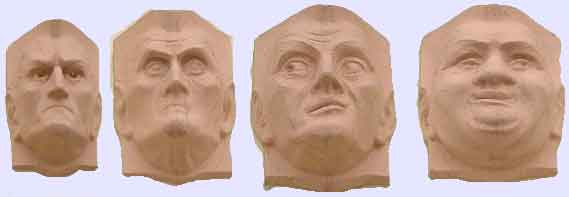.
The four humours were four fluids that were thought to permeate the body and influence its health. The concept was developed by ancient Greek thinkers around 400 BC and was directly linked with another popular theory of the four elements (Empedocles). Paired qualities were associated with each humour and its season. The four humours, their corresponding elements, seasons and sites of formation, and resulting temperaments alongside their modern equivalents are:
|
c. 400 B.C. |
Hippocrates's four humours |
yellow bile |
black bile |
phlegm |
blood |
|
|
--> |
Season: |
summer |
autumn |
winter |
spring |
|
|
--> |
Element: |
fire |
earth |
water |
air |
|
|
--> |
Organ: |
liver |
brain/lungs |
gall bladder |
spleen |
|
|
--> |
Qualities: |
dry & hot |
dry & cold |
wet & cold |
wet & hot |
|
|
--> |
Characteristics: |
easily angered, bad tempered |
despondent, sleepless, irritable |
calm, unemotional |
courageous, hopeful, amorous |
|
|
c. 325 B.C. |
Aristotle's four sources of happiness |
hedone (sensuous pleasure) |
propraitari (acquiring assets) |
ethikos (moral virtue) |
dialogike (logical investigation) |
|
|
c. 190 A.D.' |
Galen's four temperaments |
choleric |
melancholic |
phlegmatic |
sanguine |
|
|
c. 1550 |
Paracelsus's four totem spirits |
changeable salamanders |
industrious gnomes |
inspired nymphs |
curious sylphs |
|
|
c. 1905 |
Adicke's four world views |
innovative |
traditional |
doctrinaire |
skeptical |
|
|
c. 1914 |
Spränger's four value attitudes |
artistic |
economic |
religious |
theoretic |
|
|
c. 1920 |
Kretchmer's four character styles |
hypomanic |
depressive |
hyperesthetic |
anesthetic |
|
|
c. 1947 |
Erich Fromm's four orientations |
exploitative |
hoarding |
receptive |
marketing |
|
|
c. 1958 |
Myers's cognitive function types |
SP - sensory perception |
SJ - sensory judgement |
NF - intuitive feeling |
NT - intuitive thinking |
|
|
c. 1978 |
Keirsey's four temperaments |
artisan |
guardian |
idealist |
rational |
|
|
Keirsey, David (1978).Please Understand Me II: Temperament, Character, Intelligence, Prometheus Nemesis Book Co Inc; 1st ed edition (May 1, 1998). ISBN 1885705026. |
||||||
It is believed that Hippocrates was the one who applied this idea to medicine. "Humoralism" or the doctrine of the Four Temperaments as a medical theory retained its popularity for centuries largely through the influence of the writings of Galen (131–-201 AD) and was decisively displaced only in 1858 by Rudolf Virchow's newly-published theories of cellular pathology. While Galen thought that humours were formed in the body, rather than ingested, he believed that different foods had varying potential to be acted upon by the body to produce different humours. Warm foods, for example, tended to produce yellow bile, while cold foods tended to produce phlegm. Seasons of the year, periods of life, geographic regions and occupations also influenced the nature of the humours formed.
The imbalance of humours, or "dyscrasia", was thought to be the direct cause of all diseases. Health was associated with a balance of humours, or eucrasia. The qualities of the humours, in turn, influenced the nature of the diseases they caused. Yellow bile caused warm diseases and phlegm caused cold diseases.

4 humours (chol., mela., phleg. and sang.) [Source]
In On the Temperaments Galen further emphasized the importance of the qualities. An ideal temperament involved a balanced mixture of the four qualities. Galen identified four temperaments in which one of the qualities, warm, cold, moist and dry, predominated and four more in which a combination of two, warm and moist, warm and dry, cold and dry and cold and moist, dominated. These last four, named for the humours with which they were associated—that is, sanguine, choleric, melancholic and phlegmatic, eventually became better known than the others. While the term "temperament" came to refer just to psychological dispositions, Galen used it to refer to bodily dispositions, which determined a person's susceptibility to particular diseases as well as behavioral and emotional inclinations.
Methods of treatment like blood letting, emetics and purges were aimed at expelling a harmful surplus of a humour. They were still in the mainstream of American medicine after the Civil War. Other methods used herbs and foods associated with a particular humour to counter symptoms of disease, for instance: people who had a fever and were sweating were considered hot and wet and therefor given substances associated with cold and dry.
There are still remnants of the theory of the four humours in the current medical language. For example, we refer to humoral immunity or humoral regulation to mean substances like hormones and antibodies that are circulated throughout the body, or use the term blood dyscrasia to refer to any blood disease or abnormality.
The theory was a modest advance over the previous views on human health that tried to explain in terms of the divine. Since then practitioners have started to look for natural causes of disease and to provide natural treatments.
The Unani school of Indian medicine, still apparently practiced in India, is very similar to Galenic medicine in its emphasis on the four humors, and in treatments based on controlling intake, general environment, and the use of purging as a way of relieving humoral imbalances.
See also
- Disposition
- Humor theory
- Medieval medicine
| Ancient Greece
Science, Technology , Medicine , Warfare, , Biographies , Life , Cities/Places/Maps , Arts , Literature , Philosophy ,Olympics, Mythology , History , Images Medieval Greece / Byzantine Empire Science, Technology, Arts, , Warfare , Literature, Biographies, Icons, History Modern Greece Cities, Islands, Regions, Fauna/Flora ,Biographies , History , Warfare, Science/Technology, Literature, Music , Arts , Film/Actors , Sport , Fashion --- |
Retrieved from "http://en.wikipedia.org/"
All text is available under the terms of the GNU Free Documentation License
